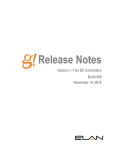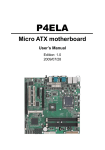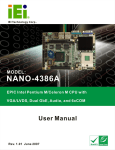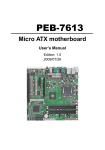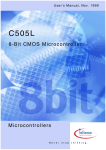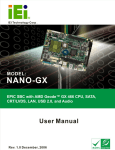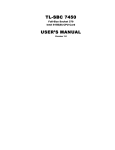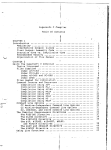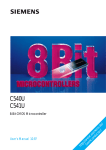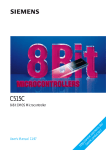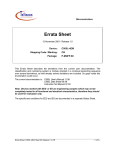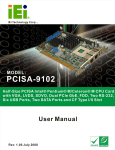Download RI7SM Series
Transcript
RI7SM Series Full-Size Socket 370 CPU Card Version 1.0 Server Board PC-Based Computer Boards for 1L/2L Server Board User’s Manual Copyright Notice This publication is protected by copyright and all rights are reserved. No part of it may be reproduced or transmitted by any means or in any form, without prior consent of the original manufacturer. The information in this document has been carefully checked and is believed to be accurate. However, the original manufacturer assumes no responsibility for any inaccuracies that may appear in this manual. In no event will the original manufacturer be liable for direct, indirect, special, exemplary, incidental, incidental or consequential damages resulting from any defect or omission in this manual, even if advised of possibility of such damages. The material contained herein is for informational purposes only. Acknowledgments Award is a registered trademark of Award Software International, Inc. PS/2 is a trademark of International Business Machines Corporation. SMI is a trademark of Silicon Motion and Technologies Inc. Intel and Celeron are registered trademarks of Intel Corporation. Microsoft Windows is a registered trademark of Microsoft Corporation. All other product names or trademarks are properties of their respective owners. Remarks: The RI7SM flexible design allows it to integrate Intel 815E, One Ethernet functions according to customer requirements. The following products are used in conjunction with the RI7SM board: l l l ii DVS72V SMI721 VGA MicroPCI Daughter Card DPR300 Promise 20265/20267 IDE RAID 0+1 MicroPCI Daughter Card DVL68V C&T 69000VGA MicroPCI Daughter Card RI7SM User’s Manual Contents Chapter 1 Introduction .............................................. 1 Checklist .................................................................... 2 Introduction............................................................... 3 Specifications ............................................................. 3 Intelligence................................................................. 6 Chapter 2 Installations ..............................................7 CPU Installation......................................................... 8 Memory Installation ................................................... 9 Jumpers on the RI7SM ............................................. 10 Connectors on the RI7SM......................................... 14 Watchdog Timer Configuration................................. 25 Chapter 3 BIOS Configuration ................................. 27 Chapter 4 815E Chipset Driver Installation Guide…..55 Chapter 5 VGA Driver Installation Guide…………...57 Chapter 6 Audio Driver Installation Guide………..…59 Chapter 7 LAN Driver Installation Guide……….…...61 Chapter 8 Ultra ATAIDE Driver Installation Guide….…81 Appendix...................................................................83 A. I/O Port Address Map ......................................... 84 B. Interrupt Request Lines (IRQ)............................. 85 RI7SM User’s Manual iii iv RI7SM User’s Manual Chapter 1 Introduction This manual is designed to give you information on the RI7SM Server Board. It is divided into the following sections: Checklist .................................................................................. 2 Introduction .............................................................................. 3 Specifications ........................................................................... 3 Intelligence............................................................................... 6 The topics covered in this chapter are as follows: u Checklist u Description u Features u Specifications u Intelligence RI7SM User’s Manual 1 Checklist Please check that your package is complete and contains the items below. If you discover damaged or missing items, please contact your dealer. • The RI7SM Server Board • This User’s Manual • 2 IDE Ribbon Cable • 1 Floppy Ribbon Connector • 2 Serial Port Ribbon Cable and 1 Parallel Port Attached to a Mounting Bracket • 1 IPC CD Driver • 1 Audio Cable W/Ext CGM Daughter Board • 1 USB cable Support two channel 2 RI7SM User’s Manual Introduction The RI7SM is one of the most efficient Server Boards in the world. It integrates the Intel Solano chipset (544BGA) or ICH2 chipset (241 BGA) and supports a Socket 370 connector for Intel Pentium III and Celeron processors with frequencies of up to 1GHz. The MicroPCI sockets used are SO-DIMM 144-pin sockets that has 120 pins used for standard PCI signals and other pins for VGA and LAN signals. Equipped with 2 MicroPCI sockets, users get to choose to insert VGA/LAN/IDE RAID MicroPCI cards. The DMPCI MicroPCI to PCI adapter can also accommodate these MicroPCI cards. Our server board provides Intel CNR chip 82562ET or 82562EM(AOL) to choose. The RI7SM is designed with a PCI bridge that is able to support 3 PCI master interfaces. MicroPCI CPU cards offer more reliability in performance and less failure rate in production by integrating all components in only one side of the PCB board. With components on one side, better design and improved quality control is achieved. Specifications • Processor Socket: Socket 370 connector • Processor: Intel Pentium III/ Celeron 500MHz~1GHz Processor • Bus Speed: 66MHz, 100MHz, 133MHz. • Chipset: Intel 815E Chipset • Secondary Cache: CPU integrated • Memory Sockets: Two 168-pin DIMM sockets Max. 512MB SDRAM Memory type: SDRAM (Synchronous DRAM) NOTE: Only SDRAM modules that support SPD (Serial Presence Detect) should be use. Use PC133 modules when running 133MHz CPU bus speed and use PC66/PC100 modules when running 66MHz /100MHz CPU bus speed. RI7SM User’s Manual 3 • BIOS: Award BIOS, PnP support • The motherboard BIOS provides “Plug & Play” which detects the peripheral devices and expansion cards of the automatically. • The motherboard provides a Desktop Management Interface (DMI) function which record your motherboard specifications • ACPI Power management • DMI BIOS Support: Desktop Management Interface (DMI) allows users to download system hardware-level information such as CPU type, CPU speed, internal/external frequencies and memory size. • LPC I/O: Winbond W83627HF • PCI TO ISA Bridge: Winbond W83628/W83629 • Parallel Port: One high-speed parallel port, SPP/EPP/ECP mode • Serial Port: Two 16550 UART compatible ports with COM1 as RS232 and COM2 as RS232 • Enhanced IDE: Two Bus Mastering EIDE mode, up to 4 devices, Two EIDE interfaces for up to four devices, support PIO Mode 4/5 or Ultra DMA 66/100 IDE Hard Disk and ATAPI CD-ROM. • FDD Interface: Two floppy drives (360KB, 720KB, 1.2MB, 1.44MB, 2.88MB, LS-120) • USB Interface: Two USB pin-header connectors, compliant with USB Specification Rev. 1.1 • DiskOnChip: The M-Systems flask disk supports system boot and storage capacity from 2MB to 288MB. • Watchdog Timer: 16-level, programmable • I/O port 0443H to enable watchdog. • I/O port 0441H to disable watchdog. • Time-out timing select 0/2/4/6/8/10/12/14/16/18/20/22/ 24/26/28/30 seconds (+/-20%). 4 RI7SM User’s Manual • VGA: Onboard Intel 815E (8/16MB VGA Chipset support Dual panel (18bit) TFT LCD. • Simultaneous CRT & LCD display • LCD panel supports DSTN/TFT • 1280x1024x8bpp colors CRT resolution • Up to 1280x1024x8bpp colors resolution for color active matrix TFT panels (12, 18, and 24bit analog) or (12+12), (18+18) double pixel/CLK interface • Green Function: Power management via BIOS, activated through mouse/keyboard movement. • ICH2 LAN Controller: DL39B LAN MicroPCI Daughter Card • ICH2 LAN controller • ICH2 LAN’s integrated LAN Controller includes a 32-bit PCI controller that provides enhanced scatter-gather bus mastering capabilities enable the LAN Controller to perform high speed data transfers over the PCI bus. In full duplex mode the LAN Controller adheres with the IEEE 802.3x Flow Control specification. • Keyboard and Mouse Connectors: PS/2 type mini-DIN that supports PC/AT; supports a 5-pin external keyboard connector • IrDA Interface: Pin-header connector for the optional IrDA external connector • PICMG Compliance: Fully compliant to PICMG standards • Environmental and Mechanical: • Power Supply: 10A @+5V(max), ±12V: 100mA(max) • Temperature: 0°C to 60°C • Humidity: 5% to 95% • Dimensions: 338mm x 122mm RI7SM User’s Manual 5 Intelligence • Temperature Monitoring and Alert: A sensor for the CPU temperature on the RI7SM monitors the CPU temperature and alerts the user through the speaker or buzzer when temperature exceeds the safe heat level. • Windows serials shut-off: Allows shut-off control from within Windows serials and through an ATX power supply. • Modem ring-on: Allows system powering on through an external modem and through AT/ATX power supply. • Year 2001 Compliant BIOS: The onboard Award BIOS is Year 2001 Compliant and will pass software applications that have the tendency to invoke INT1AH function 04H such as year2000.exe utility released by NSTL. • Wake On LAN: Through an ATX power supply and network connection, systems can be turned on from the power-off state. Wake On LAN will function properly only with an ATX power supply with 5VSB that has 800mA. 6 RI7SM User’s Manual Chapter 2 Configurations This chapter provides information on how to use the Jumpers and connectors on the RI7SM in order to set up a workable system. The topics covered are: CPU Installation ....................................................................... 8 Memory Installation.................................................................. 9 Jumpers on the RI7SM............................................................ 10 Connectors on the RI7SM....................................................... 14 Watchdog Timer Configuration .............................................. 25 CAUTION: Danger of explosion if battery is incorrectly replaced. Replace only with the same or equivalent type recommended by the manufacturer. RI7SM User’s Manual 7 CPU Installation The RI7SM Server Board supports a Socket 370 connector processor socket for Intel Pentium III, Corpermine and Celeron processors. The Socket 370 connector comes with a lever to secure the processor. Before inserting the CPU, make sure the lever is raised perpendicular to the socket and the notch on the corner of the CPU corresponds with the notch on the inside of the socket. After have installed and lock the processor into place, check if the Jumpers for the CPU type and speed are correct. NOTE: Ensure that the CPU heat sink and the CPU top surface are in total contact to avoid CPU overheating problem that would cause your system to hang or be unstable. 8 RI7SM User’s Manual Memory Installation The RI7SM Server Board supports two 168-pin DIMM sockets for a maximum total memory of 512MB SDRAMs. In populating the DIMM sockets, any of the banks can be populated first. NOTE: Use SDRAM modules with PC133 specification when running 133MHz CPU bus speed. With 66/100MHz bus speed, SDRAM modules with PC66 or PC100 specification can be used. 168-pin DIMM (3.3V) Unbuffer SDRAM Bank0 Bank1 (DIMM1) (DIMM2) Total Memory 8MB ----8MB 16MB ----16MB 32MB ----32MB 64MB ----64MB 128MB ----128MB 256MB ----256MB 8MB 8MB 16MB 16MB 8MB 24MB 32MB 8MB 40MB 64MB 8MB 72MB 128MB 8MB 136MB 256MB 8MB 264MB 16MB 16MB 32MB 32MB 16MB 48MB 64MB 16MB 80MB 128MB 16MB 144MB 256MB 16MB 272MB 32MB 32MB 64MB 64MB 32MB 96MB 128MB 32MB 160MB 256MB 32MB 288MB 64MB 64MB 128MB 128MB 64MB 192MB 256MB 64MB 320MB 128MB 128MB 320MB 256MB 128MB 384MB 256MB 256MB 512MB RI7SM User’s Manual 9 Jumpers on the RI7SM The Jumpers on the RI7SM allow you to configure your Server Board according to the needs of your applications. If you have doubts about the best jumper configuration for your needs, contact your dealer or sales representative. The following table lists the connectors on RI7SM and their respective functions. Jumper Locations on the RI7SM......................................11 JP3: AC'97 Audio Enable/Disable ...................................12 JP4: LAN EEPROM Control Content..............................12 JP5: Clear CMOS Content...............................................12 JP6: DiskOnChip BIOS Expansion Address Select ..........12 K1: Wake on LAN Connector .........................................13 J100: CRTVSYNC Jumper Setting..................................13 J101: CRTHSYNC Jumper Setting..................................13 J102, J103, J104: Light Jumper Setting ...........................13 The following examples show the conventions used in this section. Jumper Open Jumper Closed 10 RI7SM User’s Manual Jumper Locations on the RI7SM 2 7 C 2 5 6 JP3: AC'97 Audio Enable/Disable JP4: LAN EEPROM Control Content JP5: Clear CMOS Content JP6: DiskOnChip BIOS Expansion Address Select K1: Wake on LAN Connector J100: CRTVSYNC Jumper Setting J101: CRTHSYNC Jumper Setting J102, J103, J104: Light Jumper Setting RI7SM User’s Manual 11 JP3: AC'97 Audio Enable/Disable Onboard AC'97 CODEC supports the Audio function. Please refer to the default jumper setting before you proceeding with system installation. JP3 1 3 Setting Pin 2-3 Closed 1 3 Pin 1-2 Closed Function Onboard Audio Enabled Onboard Audio Disabled JP4: LAN EEPROM Control Content JP4 1 3 1 3 Setting Pin 2-3 Closed Pin 1-2 Closed Function Setting Pin 2-3 Closed Pin 1-2 Closed Function Enable Disable JP5: Clear CMOS Content JP5 1 3 1 3 Clear CMOS Content Normal Operation JP6: DiskOnChip BIOS Expansion Address Select JP6 1 Setting Pin 2-3 3 Pin 1-2 1 12 3 Function D8000-DFFFF(default) D0000-D7FFF RI7SM User’s Manual K1: Wake On LAN Connector The DL39B Realtek 8139B LAN MicroPCI daughter card supports the K1 Wake on LAN connector. The following table shows the pin out assignments of this connector. Wake On LAN will function properly only with an ATX power supply with 5VSB that has 800mA. 1 Pin # 1 2 3 2 3 Signal Name +5VSB Ground Wake on LAN J100: CRTVSYNC Jumper Setting J100 1 Setting Close 2 1 Open 2 Function INT VGA EXT VGA J101: CRTHSYNC Jumper Setting J101 1 2 1 2 Setting Close Open Function INT VGA EXT VGA J102, J103, J104: Light Jumper Setting Jumper J102, J103, J104 J102, J103, J104 1 2 1 2 RI7SM User’s Manual Setting Open Close Function EXT RED, GREEN BLUE INT RED, GREEN BLUE 13 Connectors on the RI7SM The connectors on the RI7SM allow you to connect external devices such as keyboard, floppy disk drives, hard disk drives, printers, etc. The following table lists the connectors on RI7SM and their respective functions. Connector Locations on the RI7SM .................................15 J1: RJ45 and USB Connectors .........................................16 J4: Game / MiDi Port Connector .....................................16 J6, J8: CD-ROM Audio In Connectors ............................17 J9: Front Bezel Connector ...............................................17 J11, J12: MicroPCI Connector.........................................19 JP20: PC100/133 DIMM Select .......................................19 Fan1, Fan2, Fan3 CPU Fan Power Connector..................19 IDE1, IDE2: EIDE Connectors........................................20 IR1: IrDA Connector.......................................................21 USB1, USB3/4 Connectors..............................................21 KB1: PS/2 Keyboard and PS/2 Mouse Connectors...........21 FDD1: Floppy Drive Connector ......................................22 LPT1: Parallel Port Connector.........................................22 VGA1: VGA CRT Connector ..........................................22 COM1, COM2: Serial Ports ............................................23 COM3, COM4: Serial Ports ............................................24 PCON1: ATX Power Supply Connector ..........................24 14 RI7SM User’s Manual Connector Locations on the RI7SM 2 7 C 2 5 6 J1: RJ45 and USB Connectors J4: Game / MiDi Port Connector J6, J8: CD-ROM Audio In Connectors J9: Front Bezel Connector J11, J12: MicroPCI Connector JP20: PC100/133 DIMM Select Fan1, Fan2, Fan3 CPU Fan Power Connector IDE1, IDE2: EIDE Connectors IR1: IrDA Connector USB1, USB3/4 Connectors KB1: PS/2 Keyboard and PS/2 Mouse Connectors FDD1: Floppy Drive Connector LPT1: Parallel Port Connector VGA1: VGA CRT Connector COM1, COM2: Serial Ports COM3, COM4: Serial Ports PCON1: ATX Power Supply Connector RI7SM User’s Manual 15 J1: RJ45 and USB Connectors J1 is consists an RJ-45 connector on top and two stacked USB ports at the bottom. The RJ-45 Ethernet connector supports 10/100Mbps data transfer rates. USB support allows connections of up to 64 plug and play external peripherals per channel. USB0 USB1 Pin # 1 2 3 4 Signal Name Vcc USBUSB+ Ground J4: Game / MiDi Port Connector J4 supports audio port and Joy stick respectively. It is part of the functions provided by the onboard audio controller. Audio Port & Joy stick port LineOut LineIn MicIn 16 RI7SM User’s Manual J6, J8: CD-ROM Audio In Connectors J6 and J8 are the onboard CD-ROM audio in connectors. Below are their pin assignments. 1 2 3 4 1 2 3 4 J8 J6 Signal Signal Name Signal Signal Name Name Name 1 Ground 1 Right 2 Left 2 Ground 3 Ground 3 Ground 4 Right 4 Left J9: Front Bezel Connector The front bezel of the case has a control panel that provides light indication of the computer activities and switches to change the computer status. J2 is a 20-pin header that provides interfaces for the following functions. Speaker Power LED and Keylock SMI / Hardware Switch ATX Power On Switch Turbo LED Connector Reset Switch Hard Disk Drive LED Speaker: Pins 1 - 4 This connector provides an interface to a speaker for audio tone generation. An 8-ohm speaker is recommended. Pin # Signal Name 1 Speaker out 2 No connect 3 Ground 4 +5V RI7SM User’s Manual 17 Power LED and Keylock: Pins 11 - 15 The power LED indicates the status of the main power switch. The keylock switch, when closed, will disable the keyboard function. Pin # 11 12 13 14 15 Signal Name Power LED No connect Ground Keylock Ground SMI/Hardware Switch: Pins 6 and 16 This connector supports the "Green Switch" on the control panel, which, when pressed, will force the system into the power-saving mode immediately. Pin # 6 16 Signal Name Sleep Ground ATX Power ON Switch: Pins 7 and 17 This 2-pin connector is an “ATX Power Supply On/Off Switch” on the system that connects to the power switch on the case. When pressed, the power switch will force the system to power on. When pressed again, it will force the system to power off. Pin # 7 17 Signal Name Power ON VCC5SBY Turbo LED Connector: Pins 8 and 18 There is no turbo/deturbo function on the CPU card. The Turbo LED on the control panel will always be On when attached to this connector. Pin # 8 18 18 Signal Name 5V Ground RI7SM User’s Manual Reset Switch: Pins 9 and 19 The reset switch allows the user to reset the system without turning the main power switch off and then on again. Orientation is not required when making a connection to this header. Pin # 9 19 Signal Name Reset Ground Hard Disk Drive LED Connector: Pins 10 and 20 This connector connects to the hard drive activity LED on control panel. This LED will flash when the HDD is being accessed. Pin # Signal Name 10 Ground 20 5V J11, J12: MicroPCI Connector J11 and J12 are MicroPCI connectors supporting the MicroPCI daughter cards with VGA, Ethernet or SCSI function. JP20: PC100/133 DIMM Select JP20 connector provides the option of PC100/133 DIMM for user. JP20 1 2 1 2 Setting Close Open Function For PC 133 DIMM For PC 100 DIMM Fan1, Fan2 and Fan3 CPU Fan Power Connector Fan1, Fan2 and Fan3 are 3-pin header for the CPU fans. These fans must be 12V fan. 1 2 3 RI7SM User’s Manual Pin # 1 2 3 Signal Name Rotation +12V Ground 19 IDE1, IDE2: EIDE Connectors IDE1 IDE2 20 IDE1: Primary IDE Connector Signal Name Pin # Pin # Reset IDE 1 2 Host data 7 3 4 Host data 6 5 6 Host data 5 7 8 Host data 4 9 10 Host data 3 11 12 Host data 2 13 14 Host data 1 15 16 Host data 0 17 18 Ground 19 20 DRQ0 21 22 Host IOW 23 24 Host IOR 25 26 IOCHRDY 27 28 DACK0 29 30 IRQ14 31 32 Address 1 33 34 Address 0 35 36 Chip select 0 37 38 Activity 39 40 Signal Name Ground Host data 8 Host data 9 Host data 10 Host data 11 Host data 12 Host data 13 Host data 14 Host data 15 Key Ground Ground Ground Host ALE Ground No connect No connect Address 2 Chip select 1 Ground IDE2: Secondary IDE Connector Signal Name Pin # Pin # Reset IDE 1 2 Host data 7 3 4 Host data 6 5 6 Host data 5 7 8 Host data 4 9 10 Host data 3 11 12 Host data 2 13 14 Host data 1 15 16 Host data 0 17 18 Ground 19 20 DRQ1 21 22 Host IOW 23 24 Host IOR 25 26 IOCHRDY 27 28 DACK1 29 30 IRQ15 31 32 Address 1 33 34 Address 0 35 36 Chip select 0 37 38 Activity 39 40 Signal Name Ground Host data 8 Host data 9 Host data 10 Host data 11 Host data 12 Host data 13 Host data 14 Host data 15 Key Ground Ground Ground Host ALE Ground No connect No connect Address 2 Chip select 1 Ground RI7SM User’s Manual IR1: IrDA Connector IR1 is used for an IrDA connector for wireless communication. . . 1 2 3 4 5 6 7 8 9 10 Pin # 1 2 3 4 5 Signal Name Vcc X IRRX Ground IRTX Pin # 6 7 8 9 10 Signal Name X CIRRX +5VSB X X USB1, USB3/4 Connectors The following table shows the pin outs of the USB connectors. . . USB1 Signal USB1 Signal Pin # Name Pin # Name 6 1 7 2 1 Vcc 6 Vcc 8 3 2 USBP2N 7 USBP3N 9 4 10 5 3 USBP2P 8 USBP3P 4 Ground 9 Ground 5 Ground 10 Ground KB1: PS/2 Keyboard and PS/2 Mouse Connectors PS/2 Mouse PS/2 Keyboard Below are the pin-out assignments of the connectors. Signal Name Keyboard data No Connect Ground 5V Keyboard clock No Connect RI7SM User’s Manual Keyboard 1 2 3 4 5 6 Mouse 1 2 3 4 5 6 Signal Name Mouse data No Connect No Connect 5V Mouse Clock No Connect 21 FDD1: Floppy Drive Connector FDD1 is a 34-pin header and will support up to 2.88MB floppy drives. FDD1 Signal Name Ground Ground Ground Ground Ground Ground Ground Ground Ground Ground Ground Ground Ground Ground Ground Ground Ground Pin # 1 3 5 7 9 11 13 15 17 19 21 23 25 27 29 31 33 Pin # 2 4 6 8 10 12 14 16 18 20 22 24 26 28 30 32 34 Signal Name RM/LC No connect No connect Index Motor enable 0 Drive select 1 Drive select 0 Motor enable 1 Direction Step Write data Write gate Track 00 Write protect Read data Side 1 select Diskette change LPT1: Parallel Port Connector J5 is a DB-25 external connector as seen in the previous figure. The following table describes the pin-out assignments of this connector. LPT1 22 Signal Name Pin # Pin # Signal Name Line printer strobe PD0, parallel data 0 PD1, parallel data 1 PD2, parallel data 2 PD3, parallel data 3 PD4, parallel data 4 PD5, parallel data 5 PD6, parallel data 6 PD7, parallel data 7 ACK, acknowledge Busy Paper empty Select 1 2 3 4 5 6 7 8 9 10 11 12 13 14 15 16 17 18 19 20 21 22 23 24 25 N/A AutoFeed Error Initialize Select Ground Ground Ground Ground Ground Ground Ground Ground N/A RI7SM User’s Manual VGA1: VGA CRT Connector The pin assignments of the VGA1 CRT connector are as follows: VGA1 Signal Name Red Blue GND GND N.C. N.C. HSYNC NC Pin 1 3 5 7 9 11 13 15 Pin 2 4 6 8 10 12 14 Signal Name Green N.C. GND GND GND N.C. VSYNC COM1, COM2: Serial Ports COM1 and COM2 both 10-pin header connectors, are the onboard serial ports of the RI7SM. The following table shows the pin assignments of this connector. COM1 . COM2 RI7SM User’s Manual Pin # 1 2 3 4 5 6 7 8 9 Signal Name DCD, Data carrier detect RXD, Receive data TXD, Transmit data DTR, Data terminal ready GND, ground DSR, Data set ready RTS, Request to send CTS, Clear to send RI, Ring indicator Pin # Signal Name 1 2 3 4 5 6 7 8 9 10 DCD, Data carrier detect RXD, Receive data TXD, Transmit data DTR, Data terminal ready GND, ground DSR, Data set ready RTS, Request to send CTS, Clear to send RI, Ring indicator NC 23 COM3, COM4: Serial Ports COM3 and COM4 both 10-pin header connectors, are the onboard serial ports of the RI7SM. The following table shows the pin assignments of this connector. Pin # Signal Name Pin # Signal Name 1 2 3 4 5 -HDCD3 HSIN3 HSOUT3 -HDTR3 Ground 6 7 8 9 10 -HDSR3 -HRTS3 -HCTS3 HRI3 NC Pin # Signal Name Pin # Signal Name 1 2 3 4 5 -HDCD4 HSIN4 HSOUT4 -HDTR4 Ground 6 7 8 9 10 -HDSR4 -HRTS4 -HCTS4 HRI4 NC . COM3 . COM4 PCON1: ATX Power Supply Connector PCON1 is a 20-pin ATX power supply connector. Refer to the following table for the pin out assignments. 11 24 Signal Name 3.3V -12V Ground PS-ON Ground Ground Ground -5V +5V +5V Pin # 11 12 13 14 15 16 17 18 19 20 Pin # 1 2 3 4 5 6 7 8 9 10 Signal Name 3.3V 3.3V Ground +5V Ground +5V Ground Power good 5VSB +12V RI7SM User’s Manual Watchdog Timer Configuration The function of the watchdog timer is to reset the system automatically and is defined at WinbonW83627HF. To enable the watchdog timer and allow the system to reset, the timer has a tolerance of 20% for its intervals. The following example is writing in Intel 8086 assembly language and describes how the timer should be programmed. ------------------------------------------------------------------------------------The setting Active allows you to select logic device 8. ------------------------------------------------------------------------------------MOV DX, 2EH MOV AL, 87H OUT DX, AL OUT DX, AL MOV DX, 2EH MOV AL, 07H OUT DX, AL point to Logical Device Number Reg. MOV DX, 2FH MOV AL, 08H OUT DX, AL select logical device 8 MOV DX, 2EH MOV AL, 30H OUT DX, AL select CR30 MOV DX, 2FH MOV AL, 01H OUT DX, AL update CR30 with value 01H, Active GPIO2 RI7SM User’s Manual 25 ------------------------------------------------------------------------------------Exit extended function mode ------------------------------------------------------------------------------------MOV DX, 2EH MOV AL, F5H OUT DX, AL MOV, DX, 2FH MOV AL, 00L OUT DX, AL Noted: In minutes setting function, it is recommended that this value number is 08; In seconds setting function, it is recommended that this value number is 00. ------------------------------------------------------------------------------------MOV DX, 2EH MOV AL, F6H OUT DX, AL MOV, DX, 2F MOV AL, 05 OUT DX, AL Noted: To get enable message, you can choose the values from 1; By the same token, to get disable message, you can select the values from 0. To setup watchdog timer function by debug.exe file, you can consult the sample setting from this table. WATCHDOG TIMER CONTROL TABLE Level 0 1 2 3 4 5 6 . . 255 26 Value 0 1 2 3 4 5 6 . . 255 Time/sec Disable 0.5 1.5 2.5 3.5 4.5 5.5 . . 254.5 RI7SM User’s Manual Chapter 3 BIOS Configuration This chapter describes the different settings available in the Award BIOS that comes with the CPU card. The topics covered in this chapter are as follows: BIOS Introduction .......................................................... 31 BIOS Setup..................................................................... 31 Standard CMOS Setup.................................................... 33 Date...................................................................... 33 Time..................................................................... 34 Primary HDDs / Secondary HDDs ........................ 34 Drive A / Drive B ................................................. 35 Video.................................................................... 35 Halt On ................................................................ 35 Advanced BIOS Features Setup ...................................... 36 Virus Warming..................................................... 36 CPU Internal Cache / External Cache................... 36 CPU L2 Cache ECC Checking.............................. 36 Processor Number Feature .................................... 36 Quick Power On Self Test..................................... 37 First Boot device................................................... 37 Second Boot device … … … … … … … … … … … … 37 Third Boot device … … … … … … … … … … … … .37 Swap Floppy Drive … … … … … … … … … … … … 37 Boot Up Floppy Seek ............................................ 37 Boot Up NumLock Status ..................................... 37 Gate A20 Option .................................................. 37 Gate A20 Option .................................................. 37 Typematic Rate Setting......................................... 37 RI7SM User’s Manual 27 Typematic Rate (Chars/Sec) ..................................37 Typematic Delay (Msec)........................................38 Security Option .....................................................38 OS Select for DRAM > 64MB...............................38 Report No FDD for Win95 ....................................38 Video BIOS Shadow .............................................39 C8000-CBFFF Shadow/DC000-DFFFF Shadow...39 Advanced Chipset Features Setup....................................39 SDRAM CAS Latency Time .................................39 SDRAM Cycle Time Tras/Trc … … … … … … … … 39 SDRAM RAS-to-CAS Delay… … … … … … … … ...40 SDRAM RAS Precharge Time ..............................40 System BIOS Cacheable........................................40 Video BIOS Cacheable..........................................40 Memory Hole at 15MB - 16MB.............................40 CPU Latency Timer...............................................40 Delayed Transaction..............................................40 AGP Graphics Aperture Size ................................40 Display Cache Frequency ......................................41 System Memory Frequency....................................41 On-Chip Video Window Size ................................41 Onboard Display Cache Setting.............................41 CAS# Latency.......................................................42 Paging Mode Control ............................................42 RAS-to-CAS Override...........................................42 RAS# Timing........................................................42 RAS# Precharge Timing .......................................42 Integrated Peripherals .....................................................42 OnChip Primary PCI IDE ....................................42 OnChip Secondary PCI IDE .................................42 IDE Primary Master PIO.......................................42 IDE Primary Slave PIO .........................................42 IDE Scondary Master PIO .....................................42 IDE Secondary Slave PIO......................................42 IDE Primary Master UDMA..................................42 IDE Primary Slave UDMA....................................42 IDE Scondary Master UDMA................................42 IDE Secondary Slave UDMA ................................42 USB Controller .....................................................42 USB Keyboard Support .........................................43 USB Mouse Support..............................................43 Init Display First ...................................................43 28 RI7SM User’s Manual AC97 Audio ......................................................... 43 IDE HDD Black Mode.......................................... 43 IDE HDD Black Mode.......................................... 43 Power On Function .............................................. 43 KB Power On Passward........................................ 43 Hot Key Power On................................................ 43 Onboard FDC Controller ...................................... 43 Onboard Serial Port.............................................. 44 Onboard Parallel Port ........................................... 44 UART Mode Select .............................................. 44 RxD, TxD Active ................................................. 44 IR Transmission Delay ........................................ 44 UR2 Duplex Mode ............................................... 44 Use IR Pins........................................................... 44 Onboard Parallel Port ........................................... 44 EPP Mode Select ................................................. 44 ECP Mode Use DMA ........................................... 44 Onboard Parallel Port ........................................... 44 PWRON After PW-Fail ........................................ 44 Game Port Address .............................................. 44 Midi Port Address ............................................... 44 Midi Port IRQ ...................................................... 44 Onboard Serial Port 3 .......................................... 45 Sereial Port 3 Use IRQ.......................................... 45 Onboard Serial Port 4 ........................................... 45 Sereial Port 4 Use IRQ ......................................... 45 Power Management Setup............................................... 46 ACPI Function ..................................................... 46 ACPI Suspend Tpye.............................................. 46 Power Supply Type............................................... 46 Power Management .............................................. 46 Video Off Method................................................. 47 Video Off In Suspend ........................................... 47 Suspend Type ....................................................... 47 Modem Use IRQ................................................... 47 Suspend Mode ...................................................... 47 HDD Power Down ................................................ 47 Soft-Off by PWR-BTTN ....................................... 47 Wake-Up by PCI Card ......................................... 47 PWR On by Ring.................................................. 48 CPU Thermal-Throtting ....................................... 48 Resume by Alarm ................................................ 48 RI7SM User’s Manual 29 Reload Global Timer Events..................................48 Primary IDE 0.......................................................48 Primary IDE1........................................................48 Secondary IDE 0 ...................................................48 Secondary IDE 1 ...................................................48 FDD, COM, LPT Port ...........................................48 PCI PIRQ(A-D)#...................................................48 PNP/PCI Configuration ...................................................49 PNP OS Installed ..................................................49 Reset Configuration Data ......................................49 ResourcesController by..........................................49 IRQ Resources/DMA Resources ............................49 PCI/VGA Palette Snoop ........................................50 PC Health Status .............................................................50 CPU Warning Temerature.....................................50 Current System Temp............................................50 Current CPU1 Temperature...................................50 Current CPU1FAN1 Speed....................................50 Current CPU1FAN2 Speed....................................50 INO (V) ................................................................50 IN1 (V) .................................................................50 IN2 (V) .................................................................50 +5V.......................................................................50 +12V.....................................................................50 -12V......................................................................50 -5V .......................................................................50 VBAT(V)..............................................................50 5VSB(V)...............................................................50 Shutdown Temperature........................................51 Frequency/Voltage Control..............................................51 Auto Detect DIMM/PCI Clk..................................51 CPU Clock Spectrum ............................................51 CPU HOST/PCI Clock/PC133...............................51 CPU Clock Ratio...................................................51 Load Fial-Safe/Optimized Defaults..................................52 Set Supervisor / User Password........................................53 Save & Exit Setup ...........................................................53 Exit Without Saving........................................................54 30 RI7SM User’s Manual BIOS Introduction The Award BIOS (Basic Input/Output System) installed in your computer system’s ROM supports Intel Pentium II processors in a standard IBM-AT compatible I/O system. The BIOS provides critical low-level support for a standard device such as disk drives, serial ports and parallel ports. It also adds virus and password protection as well as special support for detailed fine-tuning of the chipset controlling the entire system. BIOS Setup The Award BIOS provides a Setup utility program for specifying the system configurations and settings. The BIOS ROM of the system stores the Setup utility. When you turn on the computer, the Award BIOS is immediately activated. Pressing the <Del> key immediately allows you to enter the Setup utility. If you are a little bit late pressing the <Del> key, POST (Power On Self Test) will continue with its test routines, thus preventing you from invoking the Setup. If you still wish to enter Setup, restart the system by pressing the ”Reset” button or simultaneously pressing the <Ctrl>, <Alt> and <Delete> keys. You can also restart by turning the system Off and back On again. The following message will appear on the screen: Press <DEL> to Enter Setup In general, you press the arrow keys to highlight items, <Enter> to select, the <PgUp> and <PgDn> keys to change entries, <F1> for help and <Esc> to quit. When you enter the Setup utility, the Main Menu screen will appear on the screen. The Main Menu allows you to select from various setup functions and exit choices. RI7SM User’s Manual 31 CMOS SETUP UTILITY-Copyright ( C ) 1984-2001 The section below the setup items of the Main Menu displays the control keys for this menu. At the bottom of the Main Menu just below the control keys section, there is another section which displays information on the currently highlighted item in the list. NOTE: If your computer cannot boot after making and saving system changes with Setup, the Award BIOS supports an override to the CMOS settings that resets your system to its default. We strongly recommend that you avoid making any changes to the chipset defaults. These defaults have been carefully chosen by both Award and your system manufacturer to provide the absolute maximum performance and reliability. 32 RI7SM User’s Manual Standard CMOS Setup The “Standard CMOS Setup” choice allows you to record some basic hardware configurations in your computer system and set the system clock and error handling. If the motherboard is already installed in a working system, you will not need to select this option. You will need to run the Standard CMOS option, however, if you change your system hardware configurations, the onboard battery fails, or the configuration stored in the CMOS memory was lost or damaged. CMOS Setup Utility – Copyright (C) 1984-2001 STANDARD CMOS SETUP AWARD BIOS INC. At the bottom of the menu are the control keys for use on this menu. If you need any help in each item field, you can press the <F1> key. It will display the relevant information to help you. The memory display at the lower right-hand side of the menu is read-only. It will adjust automatically according to the memory changed. The following describes each item of this menu. Date The date format is: Day : Month : Date : Year : Sun to Sat 1 to 12 1 to 31 1994 to 2079 To set the date, highlight the “Date” field and use the PageUp/ PageDown or +/- keys to set the current time. RI7SM User’s Manual 33 Time The time format is: Hour : 00 to 23 Minute : 00 to 59 Second : 00 to 59 To set the time, highlight the “Time” field and use the <PgUp>/ <PgDn> or +/- keys to set the current time. Primary HDDs / Secondary HDDs The onboard PCI IDE connectors provide Primary and Secondary channels for connecting up to four IDE hard disks or other IDE devices. Each channel can support up to two hard disks; the first is the “Master” and the second is the “Slave”. To enter the specifications for a hard disk drive, you must select first a “Type”. There are 45 predefined types and 4 user definable types are for Enhanced IDE BIOS. Type from 1 to 45 are predefined. Type “User” is user-definable. For the Primary Master/Slave as well as Secondary Master/Slave, you can select “Auto” under the TYPE and MODE fields. This will enable auto detection of your IDE drives and CD-ROM drive during POST. Press <PgUp>/<PgDn> to select a numbered hard disk type or type the number and press the <Enter> key. The hard disk will not work properly if you enter incorrect information for this field. If your hard disk drive type is not matched or listed, you can use Type User to define your own drive type manually. If you select Type User, related information is asked to be entered to the following items. CYLS : Number of cylinders HEAD : Number of read/write heads PRECOMP : Write precompensation LANDZ : Landing zone SECTOR : Number of sectors SIZE : Automatically adjust according to the configuration MODE (for IDE HDD only) : Auto Normal (HD < 528MB) Large (for MS-DOS only) LBA (HD > 528MB and supports Logical Block Addressing) 34 RI7SM User’s Manual NOTE: The specifications of your drive must match with the drive table. The hard disk will not work properly if you enter incorrect information in these fields. If your hard disk drive type is not matched or listed, you can use Type User to define your own drive type manually. Drive A / Drive B These fields identify the types of floppy disk drive A or drive B that has been installed in the computer. The available specifications are: 360KB 1.2MB 720KB 1.44MB 2.88MB 5.25 in. 5.25 in. 3.5 in. 3.5 in. 3.5 in. Video This field selects the type of video display card installed in your system. You can choose the following video display cards: EGA/VGA For EGA, VGA, SEGA, SVGA or PGA monitor adapters. (default) CGA 40 Power up in 40 column mode. CGA 80 Power up in 80 column mode. MONO For Hercules or MDA adapters. Halt On This field determines whether the system will halt if an error is detected during power up. No errors The system boot will not be halted for any error that may be detected. All errors Whenever the BIOS detects a non-fatal error, the system will stop and you will be prompted (default). All, But Keyboard The system boot will not be halted for a keyboard error; it will stop for all other errors All, But Diskette The system boot will not be halted for a disk error; it will stop for all other errors. All, But Disk/Key The system boot will not be halted for a keyboard or disk error; it will stop for all others. RI7SM User’s Manual 35 Advanced BIOS Features This section allows you to configure and improve your system and allows you to set up some system features according to your preference. Figure1. CMOS Setup – Copyright ( C ) 1984-2001 Advanced Chipset Feature Setup AWARD SOFTWARE, INC. Virus Warning This item protects the boot sector and partition table of your hard disk against accidental modifications. If an attempt is made, the BIOS will halt the system and display a warning message. If this occurs, you can either allow the operation to continue or run an anti-virus program. CPU Internal Cache / External Cache When the CPU requests data, the system transfers the requested data from the main DRAM into cache memory, for even faster access by the CPU. These items allow you to enable (speed up memory access) or disable the cache function. By default, these items are Enabled. CPU L2 Cache ECC Checking When enabled, this allows ECC checking of the CPU’s L2 cache. By default, this field is Enabled. Processor Number Feature This field only appears if the processor on board is a Pentium III processor. The Processor Number Feature can be enabled or disabled. 36 RI7SM User’s Manual Quick Power On Self Test When enabled, this field speeds up the Power On Self Test (POST) after the system is turned on. If it is set to Enabled, BIOS will skip some items. First/Second/Third Boot Device These fields determine the drive that the system searches first for an operating system. The options available include Floppy, LS/ZIP, HDD-0, SCSI, CDROM, HDD-1, HDD-2, HDD-3, LAN and Disable. Boot Other Device These fields allow the system to search for an operating system from other devices other than the ones selected in the First/Second/Third Boot Device. Swap Floppy Drive This item allows you to determine whether or not to enable Swap Floppy Drive. When enabled, the BIOS swaps floppy drive assignments so that Drive A becomes Drive B, and Drive B becomes Drive A. By default, this field is set to Disabled. Boot Up Floppy Seek When enabled, the BIOS will seek whether or not the floppy drive installed has 40 or 80 tracks. 360K type has 40 tracks while 760K, 1.2M and 1.44M all have 80 tracks. By default, this field is set to Enabled. Boot Up NumLock Status This allows you to activate the NumLock function after you power up the system. By default, the system boots up with NumLock On. Gate A20 Option This field allows you to select how Gate A20 is worked. Gate A20 is a device used to address memory above 1 MB. Typematic Rate Setting When disabled, continually holding down a key on your keyboard will generate only one instance. When enabled, you can set the two typematic controls listed next. By default, this field is set to Disabled. Typematic Rate (Chars/Sec) When the typematic rate is enabled, the system registers repeated keystrokes speeds. You can select speed range from 6 to 30 characters per second. By default, this item is set to 6. RI7SM User’s Manual 37 Figure 2. CMOS Setup – Copyright ( C ) 1984-2001 Advanced Chipset Feature Setup AWARD SOFTWARE, INC. Typematic Delay (Msec) When the typematic rate is enabled, this item allows you to set the time interval for displaying the first and second characters. By default, this item is set to 250msec. Security Option This field allows you to limit access to the System and Setup. The default value is Setup. When you select System, the system prompts for the User Password every time you boot up. When you select Setup, the system always boots up and prompts for the Supervisor Password only when the Setup utility is called up. OS Select for DRAM > 64MB This option allows the system to access greater than 64MB of DRAM memory when used with OS/2 that depends on certain BIOS calls to access memory. The default setting is Non-OS/2. Report No FDD For WIN 95 This option allows Windows 95 to share with other peripherals IRQ6 which is assigned to a floppy disk drive if the drive is not existing. The default setting is No 38 RI7SM User’s Manual Video BIOS Shadow This item allows you to change the Video BIOS location from ROM to RAM. Video Shadow will increase the video speed. C8000 - CBFFF Shadow/DC000 - DFFFF Shadow Shadowing a ROM reduces the memory available between 640KB to 1024KB. These fields determine whether or not optional ROM will be copied to RAM. Advanced Chipset Features This Setup menu controls the configuration of the motherboard chipset. Figure1. CMOS Setup Utility – Copyright ( C ) 1984-2001 Advanced CHIPSET FEATURES AWARD SOFTWARE INC. SDRAM CAS Latency Time You can select CAS latency time in HCLKs of 2/2 or 3/3. The system board designer should set the values in this field, depending on the DRAM installed. Do not change the values in this field unless you change specifications of the installed DRAM or the installed CPU. The choices are 2 and 3. SDRAM Cycle Time Tras/Trc The settings available for the SDRAM Cycle Time Tras/Trc are 7/9, 5/7 and Auto. The default setting is 7/9. RI7SM User’s Manual 39 SDRAM RAS-to-CAS Delay You can select RAS to CAS Delay time in HCLKs of 2/2 or 3/3. The system board designer should set the values in this field, depending on the DRAM installed. Do not change the values in this field unless you change specifications of the installed DRAM or the installed CPU. The choices are 2, 3 and Auto. The default setting is 3. SDRAM RAS Precharge Time This option defines the length of time for Row Address Strobe is allowed to precharge. The choices are 2 and 3. System BIOS Cacheable The setting of Enabled allows caching of the system BIOS ROM at F000h-FFFFFh, resulting in better system performance. However, if any program writes to this memory area, a system error may result. Video BIOS Cacheable The Setting Enabled allows caching of the video BIOS ROM at C0000h-F7FFFh, resulting in better video performance. However, if any program writes to this memory area, a system error may result. Memory Hole At 15M-16M In order to improve performance, certain space in memory can be reserved for ISA cards. This memory must be mapped into the memory space below 16 MB. The choices are Enabled and Disabled. CPU Latency Timer This field enable or disable the CPU latency timer. The default setting is Enabled. Delayed Transaction The chipset has an embedded 32-bit posted write buffer to support delay transactions cycles. Select Enabled to support compliance with PCI specification version 2.1. AGP Graphics Aperture Size The field sets aperture size of the graphics. The aperture is a portion of the PCI memory address range dedicated for graphics memory address space. Host cycles that hit the aperture range are forwarded to the AGP without any translation. The options available are 32M and 64M. The default setting is 64M. 40 RI7SM User’s Manual Display Cache frequency The Frequency setting available for this item are 100MHz, 133MHz and Auto. The default setting is 100MHz. System Memory frequency The Frequency setting available for this item are 100MHz, 133MHz and Auto. The default setting is Auto. On-Chip Video Window Size The setting choices for the On-Chip Video Window Size are 64MB and Disable. By default, this option is set to 64MB. Onboard Display Cache Setting The default setting and optional setting for the onboard display cache functions are as follows: CAS# Latency 3(default), 2(option) Paging Mode Control Open (default), Close (option) RAS-to-CAS Override by CAS# LT (default), Override (2)(option) RAS# Timing Fast (default), Slow (option) RAS# Precharge Timing Fast (default), Slow (option) CMOS Setup Utility – Copyright ( C ) 1984-2001 ADVANCED CHIPSET FEATURES AWARD SOFTWARE INC. RI7SM User’s Manual 41 Integrated Peripherals This option sets your hard disk configuration, mode and port. CMOS Setup Utility – Copyright ( C ) 1984-2001 INTEGRATED PERIPHERIAL AWARD SOFTWARE INC. On-Chip Primary/Secondary PCI IDE The integrated peripheral controller contains an IDE interface with support for two IDE channels. Select Enabled to activate each channel separately. IDE Primary/Secondary Master/Slave PIO These fields allow your system hard disk controller to work faster. Rather than have the BIOS issue a series of commands that transfer to or from the disk drive, PIO (Programmed Input/Output) allows the BIOS to communicate with the controller and CPU directly. The system supports five modes, numbered from 0 (default) to 4, which primarily differ in timing. When Auto is selected, the BIOS will select the best available mode. IDE Primary/Secondary Master/Slave UDMA These fields allow your system to improve disk I/O throughput to 33Mb/sec with the Ultra DMA/33 feature. The options are Auto and Disabled. USB Controller The options for this field are Enabled and Disabled. By default, this field is set to Enabled. 42 RI7SM User’s Manual USB Keyboard Support Select Enabled if your system contains a Universal Serial Bus (USB) controller and you have a USB keyboard. USB Mouse Support Select Enabled if your system contains a Universal Serial Bus (USB) controller and you have a USB mouse. Init Display First This field allows the system to initialize first the VGA card on chip or the display on the PCI Slot. By default, the PCI Slot VGA is initialized first. AC'97 Audio The options for this field are Auto and Disabled. Default setting is Auto. IDE HDD Block Mode This field allows your hard disk controller to use the fast block mode to transfer data to and from your hard disk drive. Power on Function It offers many options to setup at the Power On Function. There are Hot Key, Mouse Left, Mouse Right, Any Key, Button Only, Keyboard 98 and Password to select. The default setting is Button Only. KB Power On Password Type correct password with keyboard. The default setting is Enter. Hot Key Power on Users can select the function they want from Ctrl+F1 to Ctrl+F12 with Hot Key Power On function setting. Onboard FDC Controller Select Enabled if your system has a floppy disk controller (FDC) installed on the system board and you wish to use it. If you install an add-in FDC or the system has no floppy drive, select Disabled in this field. This option allows you to select the onboard FDD port. Onboard Serial/Parallel Port These fields allow you to select the onboard serial and parallel ports and their addresses. The default values for these ports are: Serial Port 1 Serial Port 2 Parallel Port RI7SM User’s Manual 3F8/IRQ4 2F8/IRQ3 378H/IRQ7 43 UART Mode Select This field determines the UART mode in your computer. The settings are Normal, IrDA and ASKIR. The default value is Normal. RxD, TxD Active The settings for this field are Hi,Lo, Lo,Hi, Lo,Lo, and Hi,Hi. IR Transmission Delay By default, this field is set to Enabled. UR2 Duplex Mode The settings available for this field are Half (default) and Full. Use IR Pins The settings for this field are IR, Rx2Tx2 (default) and RxD2, TxD2. Onboard Parallel Port The setting for this field are 378/IRQ7, 278/IRQ5, 2BC/IRA7 and Disabled. By default, the onboard parallel port is set to 378/IRQ7. Parallel Port Mode/ EPP Mode/ ECP Mode Use DMA This field allows you to determine parallel port mode function. SPP Normal Printer Port (Default) EPP Enhanced Parallel Port, default setting is EPP 1.7 ECP Extended Capabilities Port, default setting is 3 PWRON After PW-Fail In case of power failure, the system can be configured to power on or to remain off when the power returns. These two settings are Former-Sts and Off respectively. The default setting for this field is Off. Game Port Address The option settings for this field are 201, 209 and Disabled. The default setting is 201. Midi Port Address The option settings for this field are 330, 400 and Disabled. The default setting is 330. Midi Port IRQ The option settings for this field are 5 and 10. The default setting is 5. 44 RI7SM User’s Manual Onboard Serial Port 3 The settings for this field are 3F8H, 2F8H, 3E8H, 2E8H and Disabled. By default, the onboard parallel port is set to 3E8H. Serial Port 3 use IRQ The option settings for this field are 5, 4, 3, 10 and 11. The default setting is 5. Onboard Serial Port 4 The settings for this field are 3F8H, 2F8H, 3E8H, 2E8H and Disabled. By default, the onboard parallel port is set to 2E8H. Serial Port 4 use IRQ The option settings for this field are 5, 4, 3, 10 and 11. The default setting is 11. CMOS Setup Utility – Copyright ( C ) 1984-2001 INTEGRATED PERIPHERIAL AWARD SOFTWARE INC. RI7SM User’s Manual 45 Power Management Setup The Power Management Setup allows you to save energy of your system effectively. It will shut down the hard disk and turn off video display after a period of inactivity. ROM PCI/ISA BIOS POWER MANAGEMENT SETUP AWARD SOFTWARE, INC. ACPI Function This Item allows you to Enabled/Disabled the Advanced Configuration Power Management (ACPI). The settings are Enabled and Disabled. ACPI Suspend Type The options for the ACPI Suspend Type field is S1(POS) Power Management This field allows you to select the type of power saving management modes. There are four selections for Power Management. Min. Power Saving Max. Power Saving User Define NOTE: 46 Minimum power management Maximum power management. Each of the ranges is from 1 min. to 1hr. Except for HDD Power Down which ranges from 1 min. to 15 min. (Default) In order to enable the CPU overheat protection feature, the Power Management field should not be set to Disabled. RI7SM User’s Manual Video Off Method This field defines the Video Off features. There are three options. V/H SYNC + Blank, blank the screen and turn off vertical and horizontal scanning. DPMS Allows the BIOS to control the video display card if it supports the DPMS feature. (Default) Blank Screen This option only writes blanks to the video buffer. Video Off In Suspend This determines the manner in which the monitor is blanked. The settings are: Yes and No. Suspend Type Select the Suspend Type. The settings are: PWRON Suspend, Stop Grant Modem Use IRQ This field names the interrupt request (IRQ) line assigned to the modem (if any) on your system. Activity of the selected IRQ always awakens the system. By default, the IRQ is set to 3. Suspend Mode When enabled, and after the set time of system inactivity, all devices except the CPU will be shut off. HDD Power Down When enabled, and after the set time of system inactivity, the hard disk drive will be powered down while all other devices remain active. Soft-Off by PWR-BTTN This field defines the power-off mode when using an ATX power supply. The Instant-Off mode allows powering off immediately upon pressing the power button. In the Delay 4 Sec mode, the system powers off when the power button is pressed for more than four seconds or places the system in a very low-power-usage state, with only enough circuitry receiving power to detect power button activity or Resume by Ring activity (see next field) when pressed for less than 4 seconds. The default value is Instant-Off. Wake-Up by PCI Card When Disable, use PCI card to operate Wake On LAN function. RI7SM User’s Manual 47 PWR On by Ring An input signal on the serial Ring Indicator (RI) line (in other words, an incoming call on the modem) awakens the system from a soft off state. CPU Thermal-Throttling The CPU Thermal Throttling function, by default, is set to 62.5% Resume by Alarm This field enables or disables the resumption of the system operation. When enabled, the user is allowed to set the Date and Time. Reload Global Timer Events The HDD, FDD, COM, LPT Ports and PCI PIRQ are I/O events which can prevent the system from entering a power saving mode or can awaken the system from such a mode. When an I/O device wants to gain the attention of the operating system, it signals by causing an IRQ to occur. When the operating system is ready to respond to the request, it interrupts itself and performs the service. Figurer 2 48 RI7SM User’s Manual PNP/PCI Configuration This option configures the PCI bus system. All PCI bus systems on the system use INT#, thus all installed PCI cards must be set to this value. ROM PCI/ISA BIOS PNP/PCI CONFIGURATION AWARD SOFTWARE INC. PNP OS Installed This field allows you to specify if the operating system installed in your system is plug and play aware. Reset Configuration Data This field allows you to determine whether or not to reset the configuration data. The default value is Disabled. Resources Controlled by This PnP BIOS can configure all of the boot and compatible devices automatically. However, this capability needs you to use a PnP operating system such as Windows 95. The default value is Auto(ESCD). Auto(ESCD)/Manual Every peripheral device has a node which is called ESCD. This node records which resource is assigned to it. The system needs to record and update ESCD to the memory locations. Default setting is Auto(ESCD). RI7SM User’s Manual 49 PCI / VGA Palette Snoop Leave this filed at Disabled. These settings are Enabled, Disabled. PC Health Status This section presents the States of your CPU, Fan, Warning for overall system status. CMOS Setup Utility – Copyright ( C ) 1984-2001 Award Software PC Health Status AWARD SOFTWARE INC. CPU Warning Temperature During Enabled, this will warn the user when the CPU temperature reach a certain temperature. Temperatures/Fan Speeds/Voltages These fields are the parameters of the hardware monitoring function feature of the motherboard. The values are read-only values as monitored by the system and show the PC health status. Shutdown Temperature This option is for setting the Shutdown temperature level for the processor. When the processor reaches the temperature you set, this will shutdown the system. 50 RI7SM User’s Manual Frequency/ Voltage Control This section is for setting CPU Frequency/ Voltage Control. CMOS Setup Utility – Copyright ( C ) 1984-2001 Award Software Frequency / Voltage Control AWARD SOFTWARE INC. Auto Detect DIMM/PCI ClK This item allows you to enable/disable auto detect DIMM/PCI Clock. The setting are: Enabled / Disabled. Spread Spectrum This item allows you to set the CPU Clock / Spread Spectrum. CPU Host /PCI Clock/PC133 The CPU Host /PCI Clock/PC133 has the setting of Default which supports 133MHz only or above by the system. CPU Clock Ratio The CPU Ratio, also known as the CPU bus speed multiplier, can be configured as 3, 3.5, 4, 4.5, 5, 5.5, 6, 6.5, 7, 7.5, and 8. RI7SM User’s Manual 51 Load Fail-Safe Defaults This option allows you to load the troubleshooting default values permanently stored in the BIOS ROM. These default settings are non-optimal and disable all high-performance features. Load Fail-Safe Defaults Setup Utility – Copyright © 1984-2001 Award Software Standard CMOS Features Advanced BIOS Features Advanced Chipset Features Integrated Peripherals Power Management Setup PnP/PCI Configurations PC Health Status Frequency/Voltage Control Load Fail-Safe Defaults Load Optimized Defaults Set Supervisor Password Set User Password Save & Exit Setup Exit Without Saving ESC : Quit F10 : Save & Exit Setup á â à ß : Select Item Load Optimized Defaults This option allows you to load the default values to your system configuration. These default settings are optimal and enable all high performance features. Load Optimized Defaults Setup Utility – Copyright © 1984-2001 Award Software 52 Standard CMOS Features Advanced BIOS Features Advanced Chipset Features Integrated Peripherals Power Management Setup PnP/PCI Configurations PC Health Status Frequency/Voltage Control Load Fail-Safe Defaults Load Optimized Defaults Set Supervisor Password Set User Password Save & Exit Setup Exit Without Saving ESC : Quit F10 : Save & Exit Setup á â à ß : Select Item RI7SM User’s Manual Set Supervisor / User Password These two options set the system password. Supervisor Password sets a password that will be used to protect the system and Setup utility. User Password sets a password that will be used exclusively on the system. To specify a password, highlight the type you want and press <Enter>. The Enter Password: message prompts on the screen. Type the password, up to eight characters in length, and press <Enter>. The system confirms your password by asking you to type it again. After setting a password, the screen automatically returns to the main screen. To disable a password, just press the <Enter> key when you are prompted to enter the password. A message will confirm the password to be disabled. Once the password is disabled, the system will boot and you can enter Setup. Set Supervisor / User Password Utility – Copyright © 1984-2001 Award Software Standard CMOS Features Frequency/Voltage Control Advanced BIOS Features Load Fail-Safe Defaults Advanced Chipset Features Load Optimized Defaults Integrated Peripherals Set Supervisor Password Power Management Setup Set User Password Enter Password: PnP/PCI Configurations Save & Exit Setup PC Health Status Exit Without Saving ESC : Quit F10 : Save & Exit Setup á â à ß : Select Item Save & Exit Setup This option allows you to determine whether to accept the modifications or not. If you type “Y”, you will quit the setup utility and save all changes into the CMOS memory. If you type “N”, you will return to Setup utility. Save & Exit Setup Utility – Copyright © 1984-2001 Award Software Standard CMOS Features Frequency/Voltage Control Advanced BIOS Features Load Fail-Safe Defaults Advanced Chipset Features Load Optimized Defaults Integrated Peripherals Set Supervisor Password Power Management Setup SetExit User(Y/N)? Password Save to CMOS and N PnP/PCI Configurations Save & Exit Setup PC Health Status Exit Without Saving ESC : Quit F10 : Save & Exit Setup RI7SM User’s Manual á â à ß : Select Item 53 Exit Without Saving Select this option to exit the Setup utility without saving the changes you have made in this session. Typing “Y” will quit the Setup utility without saving the modifications. Typing “N” will return you to Setup utility. Exit Without Saving Utility – Copyright © 1984-2001 Award Software Standard CMOS Features Frequency/Voltage Control Advanced BIOS Features Load Fail-Safe Defaults Advanced Chipset Features Load Optimized Defaults Integrated Peripherals Set Supervisor Password Power Management Setup Set User Password PnP/PCI Configurations Save & Exit Quit Without Saving (Y/N)? N Setup PC Health Status Exit Without Saving ESC : Quit F10 : Save & Exit Setup 54 á â à ß : Select Item RI7SM User’s Manual Chapter 4 815E Chipset Driver Installation Guide This chapter provides information on how to install the 815E Chipset Driver that comes in this driver CD with the package. Please follow the instructions set forth in this chapter carefully. Please note that this 815E Chipset Driver must be installed in your system first before you could proceed to install the relevant drivers. The following items are covered in this chapter: Installing the Drivers for Windows 98SE ............................. 56 Installing the Drivers for Windows 2000 ............................... 56 RI7SM User’s Manual 55 Installing the 815E Chipset Drivers for Windows 98SE Windows 2000 The following section describes the 815E Chipset driver installation procedures for Windows 98SE and Windows 2000. Step 1: Insert driver CD into CD-ROM. Step 2: Click Server. Step 3: Click RI7SM. Step 4: Click Intel 815, 815E Chipset Driver. Step 5: Click Next. Step 6: Click Yes. Step 7: Click Next. Step 8: Click Finish. You must restart your computer now. 56 RI7SM User’s Manual Chapter 5 VGA Driver Installation Guide This chapter provides information on how to install VGA drivers that comes in this CD driver with the package. Please follow the instructions set forth in this chapter carefully. Please note that there must be relevant software installed in your system before you could proceed to install the VGA drivers. The following items are covered in this chapter: Installing the Drivers for Windows 98SE ................................ 58 Windows Me and Windows 2000............................................ 58 Windows Me and Windows Millennium Edition..................... 58 Windows Me and Windows NT 4.0 ........................................ 58 RI7SM User’s Manual 57 Installing the 815E VGA Drivers for Windows 98SE Windows 2000 Windows Millennium Edition Windows NT 4.0 The following section describes the 815E VGA driver installation procedures for Windows 98SE, Windows 2000, Windows Millennium Edition and Windows NT 4.0. Step 1: Insert driver CD into CD-ROM. Step 2: Click Server. Step 3: Click RI7SM. Step 4: Click Intel 815, 815E VGA Driver. Step 5: Click Next. Step 6: Click Yes. Step 7: Click Finish. You must restart your computer now. 58 RI7SM User’s Manual Chapter 6 Audio Driver Installation Guide This chapter provides information on how to install the AC’97 CODEC Audio Driver that comes in this driver CD with the package. Please follow the instructions set forth in this chapter carefully. Please note that there must be relevant software installed in your system before you could proceed to install the Audio drivers. The following items are covered in this chapter: Installing the Drivers for Windows 98SE ................................ 60 Installing the Drivers for Windows 2000................................. 60 Installing the Drivers for Windows Me ................................... 60 Installing the Drivers for Windows NT 4.0 ............................. 60 RI7SM User’s Manual 59 Installing the Audio Drivers for Windows 98SE Windows 2000 Windows Millennium Edition Windows NT 4.0 The following section describes the Audio driver installation procedures for Windows 98SE, Windows 2000, Windows Millennium Edition and Windows NT4.0. Step 1: Insert driver CD into CD-ROM ⇒ Server. Step 2: Click RI7SM. Step 3: Click OnChip AC97 Audio Driver. Step 4: Click Next. Step 5: Click OK. You must restart your computer now. 60 RI7SM User’s Manual Chapter 7 LAN Driver Installation Guide This chapter describes LAN features and driver installation of the onboard Intel ICH2. The following items are covered in this chapter: Introduction ............................................................................ 62 Features .................................................................................. 62 Installing LAN Driver for Win98SE/ Windows Millennium Edition ................................................................................... 63 Installing LAN Driver for Windows 2000 ............................... 73 Installing LAN Driver for Windows NT 4.0............................ 80 RI7SM User’s Manual 61 Features l l l l l l l l l 62 Support of Wired for Management (WfM) Rev 2.0Compliant Interface to discrete LAN connect component 10/100 Mbit/sec Ethernet support 1Mbit/sec HomePNA support Support wake-up on interesting packets and link status change Support for remote power-up using Wake on LAN (WOL) technology Deep power-down mode support Backward compatible software with 82557, 82558 and 82559 Support for Intel’s Adaptive Technology RI7SM User’s Manual Installing LAN Driver for Windows 98SE/ Windows Millennium Edition This section describes the procedures to install Windows 98SE driver for Intel ICH2 LAN adapter. Noted: The installation approach of Windows Millennium Edition is similar to Windows 98SE system. Step 1: Copy the file “ LAN \8255X\wol558.VXD” to C:\Windows\system from CD-ROM driver. Step 2: Copy two files “e100ba.cat” and “8255Xndi.dll” to C:\Windows \CATROOT” from CD-ROM driver. Step 3: Click Start ⇒ Settings ⇒ Control Panel. Step 4: Double click System. Step 5: Step 6: Click Driver ⇒ Update Driver. Step 7: Click Next. RI7SM User’s Manual 63 Step 8: Step 9: 64 RI7SM User’s Manual Step 10: Step 11: Click Browser ⇒ D:\LAN\8255X. Step 12: Step 13: RI7SM User’s Manual 65 Step 14: Step 15: Step 16: Neglecting this picture appears, clicks OK to next procedures. 66 RI7SM User’s Manual Step 17: Step 18: Click Yes. You must restart your computer now. Step 19: Click Start ⇒ Settings ⇒ Control Panel. Step 20: RI7SM User’s Manual 67 Step 21: Step 22: 68 RI7SM User’s Manual Step 23: Step 24: RI7SM User’s Manual 69 Step 25: Step 26: 70 RI7SM User’s Manual Step 27: Step 28: RI7SM User’s Manual 71 Step 29: Type correct CD-ROM path. ex: e:\lan\8255X ⇒ OK Step 30: Step 31: Click Yes. You must restart your computer now. 72 RI7SM User’s Manual Installing LAN Driver for Windows 2000 This section describes the procedure to install Windows 2000 driver for Intel ICH2 LAN adapter. Step 1: Click Start ⇒ Settings ⇒ Control Panel. Step 2: Double click System. Step 3: Click “Device Manager” RI7SM User’s Manual 73 Step 4: Step 5: Double click “Ethernet Controller”. Step 6: Click “Reinstall Driver”. 74 RI7SM User’s Manual Step 7: Click NEXT. Step 8: Insert driver CD into CD-ROM. Step 9: Select “Display a list of the known drivers for device so that I can choose a specific driver” ⇒ NEXT. RI7SM User’s Manual 75 Step 10: Choose “Network adapters” ⇒ NEXT”. Step 11: 76 RI7SM User’s Manual Step 12: Type correct path with CD-ROM driver. ex: e:\LAN\8255X ⇒ OK. Step 13: Choose “Intel PRO/100 VM Network Connection” ⇒ NEXT. RI7SM User’s Manual 77 Step 14: Click NEXT. Step 15: Click Finish. Step 16: Click Yes. You must restart your computer now. 78 RI7SM User’s Manual Installing LAN Driver for Windows NT 4.0 You should install the Windows NT 4.0 Service Pack 3 or above first before installing the drivers. If you do not have the Windows NT 4.0 Service Pack 3 or above, please contact your software vendor or download it from Microsoft's web site. The procedures below show you how to install the LAN drivers for Windows NT 4.0. Noted: You can select item “Intel 8255X MakeDisk Utility” from this driver CD to Make Diskette before the procedures are installing. Step 1: Insert Driver CD into CD-ROM Drive ⇒ Server ⇒ RI7SM ⇒ Intel 8255x ⇒ MakeDisk Uility. Step 2: Inset a blank disk into floppy drive ⇒ Windows NT 4.0 ⇒ Create Disk. Step 3: Click Start ⇒ Settings ⇒ Control Panel. Step 4: Double click Network. Step 5: Click Adaptor ⇒ ADD. Step 6: Insert diskette into floppy ⇒ Have Disk. Step 7: Click OK. Step 8: Click OK. Step 7: Click Close. Step 9: The LAN adapter must be filled in IP Address, Subnet Mark and Default Gateway ⇒ OK. Step 10: Click Yes. You must restart your computer now. RI7SM User’s Manual 79 This page was intentionally left blank. 80 RI7SM User’s Manual Chapter 8 Ultra ATA IDE Driver Installation Guide This chapter provides information on how to install the Ultra ATA IDE Driver that comes in this CD driver with the package. Please follow the instructions set forth in this chapter carefully. The following items are covered in this chapter: Installing the Drivers for Windows 98SE, Windows 2000, Windows Millenniun Edition and Windows NT 4.0................ 82 RI7SM User’s Manual 81 Installing Ultra ATA IDE the Drivers for Windows 98SE Windows 2000 Windows Millennium Edition Windows NT 4.0 The following section describes the Ultra ATA IDE driver installation procedure for Windows 98SE, Windows 2000, Windows Millennium Edition and Windows NT 4.0. Step 1: Insert driver CD into CD-ROM. Step 2: Click Server. Step 3: Click RI7SM. Step 4: Click Ultra ATA IDE Driver. Step 5: Click Next. Step 6: Click Yes. Step 7: Click Next. Step 8: Click Next. Step 9: Click Finish. You must restart your computer now. 82 RI7SM User’s Manual Appendix Appendix A. I/O Port Address Map B. Interrupt Request Lines (IRQ) RI7SM User’s Manual 83 Appendix A. I/O Port Address Map Each peripheral device in the system is assigned a set of I/O port addresses, which also becomes the identity of the device. There is a total of 1K port address space available. The following table lists the I/O port addresses used on the Industrial CPU Card. Address 000h - 01Fh 020h - 03Fh 040h - 05Fh 060h - 06Fh 070h - 07Fh 080h - 09Fh 0A0h - 0BFh 0C0h - 0DFh 0F0h 0F1h 1F0h - 1F7h 278 - 27F 2F8h - 2FFh 2B0 - 2DF 378h - 3FFh 360 - 36F 3B0 - 3BF 3C0 - 3CF 3D0 - 3DF 3F0h - 3F7h 3F8h - 3FFh 84 Device Description DMA Controller #1 Interrupt Controller #1 Timer Keyboard Controller Real Time Clock, NMI DMA Page Register Interrupt Controller #2 DMA Controller #2 Clear Math Coprocessor Busy Signal Reset Math Coprocessor IDE Interface Parallel Port #2(LPT2) Serial Port #2(COM2) Graphics adapter Controller Parallel Port #1(LPT1) Network Ports Monochrome & Printer adapter EGA adapter CGA adapter Floppy Disk Controller Serial Port #1(COM1) RI7SM User’s Manual Appendix B. Interrupt Request Lines (IRQ) There are a total of 15 IRQ lines available on the Industrial CPU Card. Peripheral devices use interrupt request lines to notify CPU for the service required. The following table shows the IRQ used by the devices on the Industrial CPU Card. Level IRQ0 IRQ1 IRQ2 IRQ3 IRQ4 IRQ5 IRQ6 IRQ7 IRQ8 IRQ9 IRQ10 IRQ11 IRQ12 IRQ13 IRQ14 IRQ15 RI7SM User’s Manual Function System Timer Output Keyboard Interrupt Cascade Serial Port #2 Serial Port #1 Parallel Port #2 Floppy Disk Controller Parallel Port #1 Real Time Clock Software Redirected to Int 0Ah Reserved Reserved Reserved 80287 Primary IDE Secondary IDE 85



























































































